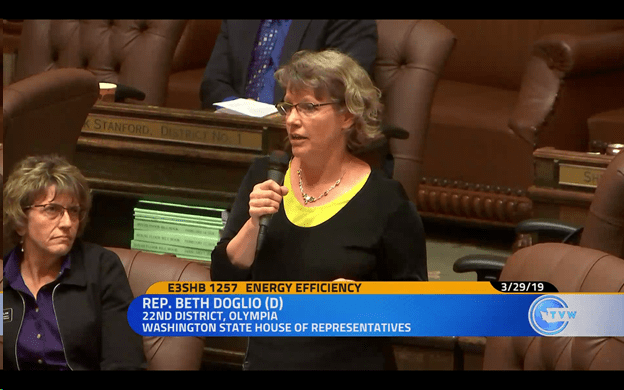House passes WA Clean Buildings bill
House passes Washington Clean Buildings bill
Key piece of Governor Jay Inslee’s climate package advances

Rep. Beth Doglio speaks in support of HB 1257, which she sponsored.
OLYMPIA, WASHINGTON — Last night’s passage of the Clean Buildings for Washington Act (HB 1257) by the state House of Representatives moves Washington one step closer to becoming a national leader in tackling one of the least recognized but biggest and fastest growing sources of greenhouse gas emissions.
Buildings are responsible for more than a quarter of all greenhouse gas emissions in Washington, and the amount has risen by 50% since 1990. These effects are offsetting progress we’re making in reducing emissions from the electricity and transportation sectors and, if not addressed, will make it impossible for Washington to meet its emission reduction goals.
The Clean Buildings Act, sponsored by Representatives Beth Doglio (D-22), Debra Lekanoff (D-40), Joe Fitzgibbon (D-34), Gael Tarleton (D-36) and many other champions, will establish energy efficiency standards for large commercial buildings of greater than 50,000 square feet. These buildings are relatively few in number – only about 6% of all commercial buildings – but make an outsized contribution to emissions.
See Nancy Hirsh’s Seattle Times Op-Ed supporting passage.
The resulting upgrades will come at little cost because building owners will not be required to make any upgrades unless the investment pays for itself in reduced electricity bills. Plus, the bill provides $75 million in incentives to assist the owners of buildings that require major capital improvements.
The bill will also set energy efficiency standards for natural gas utilities and encourage them to acquire renewable natural gas made from organic matter. And new buildings with parking will be required to be equipped with electric vehicle charging infrastructure.
“These measures together will comprehensively reduce carbon emissions from the built environment – 4.3 million metric tons by 2035, which is more than a quarter of the way to meeting Washington’s climate targets and putting us on a path to do much more,” explained Doglio.
In addition to providing major environmental benefits at little cost, the Clean Buildings for Washington Act will spur the continued expansion of Washington’s clean energy economy, which currently employs more than eighty thousand people, including more than sixty thousand in energy efficiency occupations.
“Energy efficiency creates living-wage jobs all over Washington for professionals like architects and designers; for skilled workers like HVAC mechanics, electricians, carpenters, and plumbers; and for entry-level workers in fields like weatherization and construction,” said Kerry Meade, Executive Director of the Northwest Energy Efficiency Council, a business association of the energy efficiency industry.
“Washington is leading the nation by taking decisive climate action on emissions from the built environment,” said Amy Wheeless, Policy Associate at the NW Energy Coalition, “We are addressing existing buildings with innovative policy that combines long-term standards with near-term incentives, technical assistance, and alternative compliance pathways.”
The Clean Buildings for Washington Act was unveiled as a central component of Governor Jay Inslee’s climate package this session and, along with its companions Clean Electricity (SB 5116), Appliance Standards (HB 1444), Reducing Hydrofluorocarbons (HB 1112), and Clean Fuels (HB 1110) bills, it continues to advance through the legislative process. A hearing will be held in the Senate Ways & Means committee in April. A Senate companion of the bill SB 5293, championed by Senator Reuven Carlyle has already passed through Senate committees.


